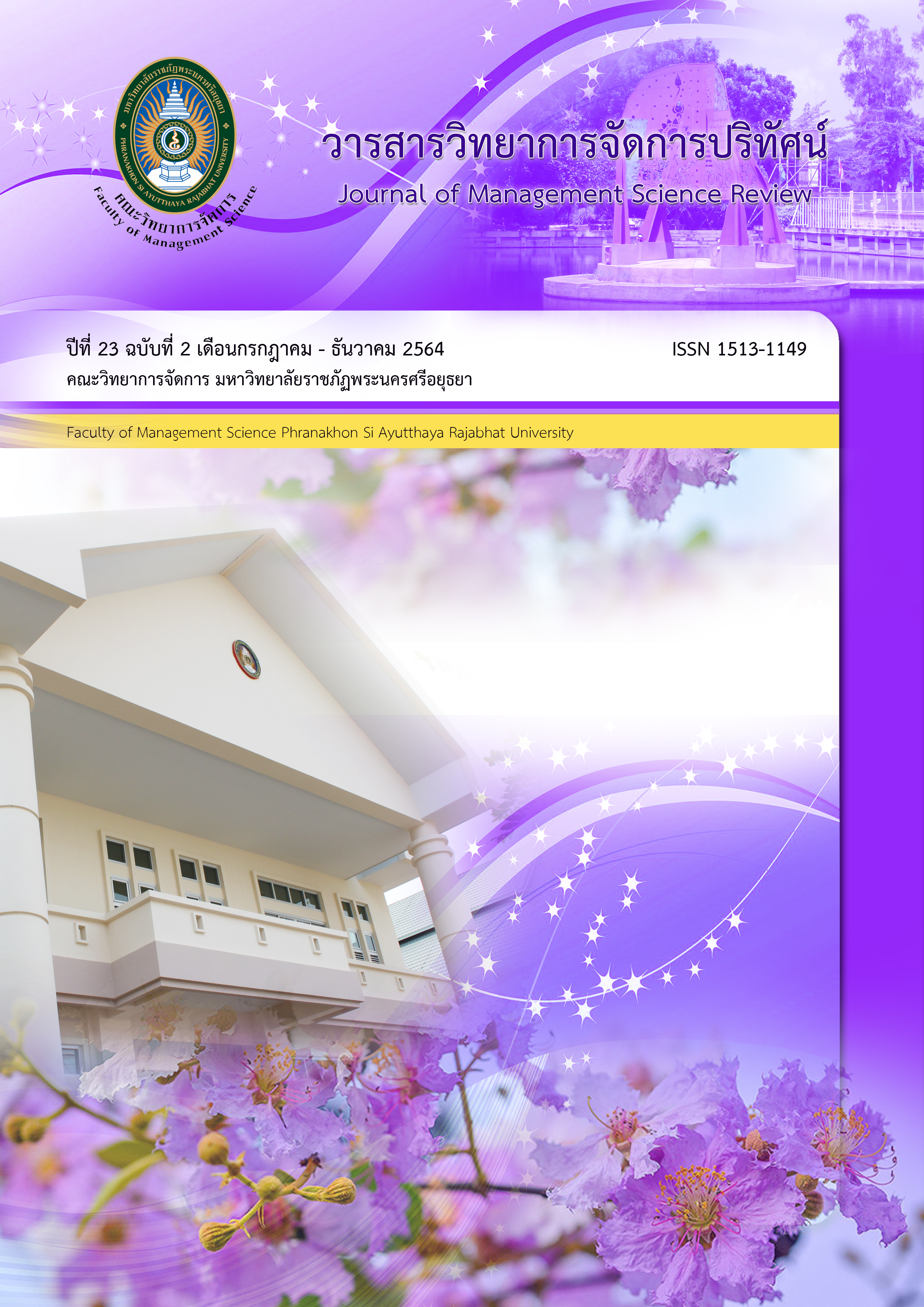การจัดลำดับแรงผลักดันสำหรับการผลิตแบบลีนสีเขียวในกลุ่มอุตสาหกรรมยานยนต์ของไทย
คำสำคัญ:
แรงผลักดัน, การผลิตแบบลีนสีเขียว, อุตสาหกรรมยานยนต์บทคัดย่อ
การศึกษาวิจัยนี้ มีวัตถุประสงค์ในการศึกษาเพื่อศึกษาลําดับความสําคัญของแรงผลักดันที่มีอิทธิพลต่อการจัดการผลิตแบบลีนสีเขียวในกลุ่มอุตสาหกรรมยานยนต์ของไทย โดยการศึกษาวิจัยครั้งนี้เป็นการวิจัยเชิงปริมาณเก็บข้อมูลโดยการแจกแบบสอบถามไปยังสถานประกอบการจํานวน 10 บริษัท โดยคัดเลือกบริษัทที่เป็นผู้นําในอุตสาหกรรมยานยนต์ที่มีความรู้ ประสบการณ์และความเชี่ยวชาญด้านการผลิตแบบลีนสีเขียวมาเป็นกลุ่มตัวอย่าง โดยใช้การวิเคราะห์น้ําหนักความสําคัญตามหลักการของ Analytic Hierarchy Process (AHP)
ผลการวิจัย การเปลี่ยนแปลงความต้องการของผู้บริโภค การสร้างภาพลักษณ์ให้กับสินค้า กฎ ระเบียบ ข้อบังคับทางกฎหมายเป็นปัจจัยสําคัญที่มีค่าน้ําหนักของแต่ละปัจจัยเกินร้อยละ 10 ที่ส่งเสริมให้การดําเนินการผลิตแบบลีนสีเขียวในกลุ่มอุตสาหกรรมยานยนต์ของไทยประสบความสําเร็จ สําหรับผลของค่าความสอดคล้อง (Consistency Ratio) จากการเปรียบเทียบลําดับขั้นของเกณฑ์ในการตัดสินใจมีค่า Incon เท่ากับ 0.02 ซึ่งหมายถึงว่า ค่า CR เป็นค่าที่ยอมรับได้เนื่องจากมีค่าน้อยกว่า 0.10
เอกสารอ้างอิง
กระทรวงอุตสาหกรรม เดินหน้าผลักดัน Roadmap พัฒนาอุตสาหกรรมยานยนต์ไฟฟ้า ตั้งเป้าผลิตยานยนต์ไฟฟ้า 30% ในปี 2030. (2563). นิตยสาร Green Network. ค้นเมื่อ มิถุนายน 2564, จาก https://www.greennetworkthailand.com/roadmap
ชุมพล มณฑาทิพย์กุล. (2543). Green supply chain เพื่อการพัฒนาที่ยั่งยืน. กรุงเทพฯ: Logistics Digest.
บุษบา พฤกษาพันธุ์รัตน์. (2552). การวางแผนและควบคุมการผลิต. กรุงเทพฯ: ท้อป.
ภูษิต วงศ์หล่อสายชล. (2555). การจัดการดำเนินงาน. กรุงเทพฯ: ท้อป.
สำนักงานนโยบายและยุทธศาสตร์การค้า (2564). ภาวะการค้าระหว่างประเทศของไทย เดือนพฤษภาคม 2564. จาก https://gnews.apps.go.th/news?news=86691
สำนักงานเศรษฐกิจอุตสาหกรรม กระทรวงอุตสาหกรรม. (2561). รายงานภาวะเศรษฐกิจอุตสาหกรรม ปี 2560 และแนวโน้มปี 2561. จาก http://www.oie.go.th/academic/
Abreu, M. F., Alves, A. C. and Moreira, F. (2017). Lean-Green models for eco-efficient and sustainable production. Journal of Energy, 137, 846-853.
Bhattacharya, A., Nand, A. and Castka, P. (2019). Lean-green integration and its impact on sustainability performance: A critical review. Journal of Cleaner Production, 236, 117697.
Cherrafi, A., Garza-Reyes, J. A., Kumar, V., Mishra, N., Ghobadian, A. and Elfezazi., S. (2018). Lean, green practices and process innovation: A model for green supply chain performance. International Journal of Production Economics, 206, 79-92.
Fercoq, A., Lamouri, S., Carbone, V., Lelievre, A. and Lemieux, A. A. (2013). Combining lean and green in manufacturing: a model of waste management (7 th ed.). in IFAC Conference on Manufacturing Modelling, Management, and Control International Federation of Automatic Control (pp.117-122). Russia: Saint Petersburg.
Fercoq, A., Lamouri, S. and Carbone, V. (2016). Lean/Green integration focused on waste reduction techniques. Journal of Cleaner Production, 137, 567-578. doi:10.1016/j.jc epro.2016.07.107.
Gandhi, N. S., Thanki, S. J. an& Thakkar, J. J. (2018). Ranking of drivers for integrated lean-green manufacturing for Indian manufacturing SMEs. Journal of Cleaner Production, 171, 675-689. doi:10.1016/j.jclepro.2017.10.041
Greinacher, S., Moser., E., Frier, J., Muller, J., and Lanza, G. (2016). Simulation based methodology for the application of lean and green strategies depending on external change driver influence. Procedia CIRP, 48, 242-247. doi:10.1016/j.procir.2016.03.240
Hajmohammad, S., Vachon, S., Klassen, R. D., and Gavronski, I. (2013). Lean management and supply management: their role in green practices and performance. Journal of Cleaner Production, 39, 312-320. doi:10.1016/ j.jclepro.2012.07.028
Johansson, G. and Sundin, E. (2014). Lean and green product development: two sides of the same coin?. Journal of Cleaner Production, (85), 104-121.
Kafuku, J. M. (2019). Factors for Effective Implementation of Lean Manufacturing Practice in Selected Industries in Tanzania. Procedia Manufacturing, 33, 351-358. doi:10.1016/j.promfg.2019.04.043
Kumar, M. and Rodrigues, V. S. (2017). Synergetic effect of lean and green on innovation: A resource-based perspective. International Journal of Production Economics, 1-11. doi:10.1016/j.ijpe.2018.04.007
Kurdve, M., Zackrisson, M., Wiktorsson, M., and Harlin, U. (2014). Lean and green integration into production system models–experiences from Swedish industry. Journal of Cleaner Production, 85, 180-190. doi:10.1016/j.jclepro.2014.04.013.
Mittal, V. K., Sindhwani, R., Kalsariya, V., Salroo, F., Sangwan, K. S. and Singh, P. L. . (2017). Adoption of Integrated Lean-Green-Agile Strategies for Modern Manufacturing Systems. Procedia CIRP, 61, 463-468. doi:10.1016/j.procir.2016.11.189.
Saaty, T., L. (1980). The Analytic Hierarchy Process. New York: McGraw-Hill,
Salleh, N. A. M., Kasolong, S., and Jaffar, A. (2012). Green Lean Total Quality Information Management in Malaysian Automotive Companies. Procedia Engineering, 41, 1708-1713.
Seth, D., Rehman, M. A. A. and Shrivastava, R. L. (2018). Green manufacturing drivers and their relationship for small and medium (SME) and large industries. Journal of Cleaner Production, 198(5), 1381-1405.
Siegel, R., Antony, J., Garza-Reyes, J. A., Cherrafi, A. and Lameijer, B. (2019). Integrated green lean approach and sustainability for SMEs: From literature review to a conceptual framework. Journal of Cleaner Production, 240, 1-14. doi:10.1016/ j.jclepro.2019.118205.
Yadav, G., Luthra, S., Huising, D. Mangla, S. K., Narkhede, B. E., and Liu, Y. (2020). Development of a lean manufacturing framework to enhance its adoption within manufacturing companies in developing economies. Journal of Cleaner Production, 245, 1-16. doi:10.1016/ j.jclepro.2019.11872





